Buckwheat Millet Flaxseed Bread
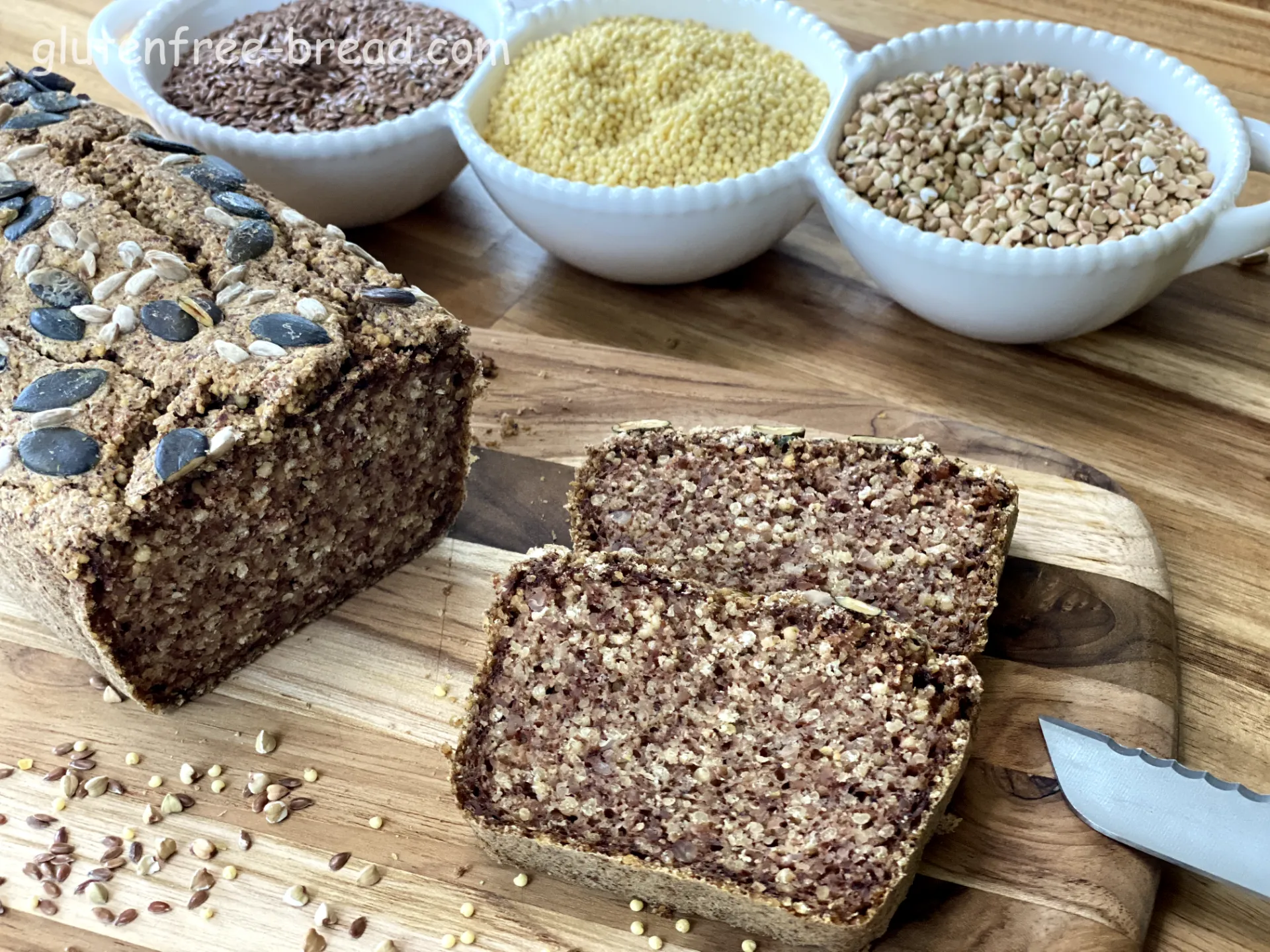
Gluten Free, Low Carbs, Sugar Free, Dairy Free, Yeast Free, Egg Free, Vegan, Nut Free
Ingredients:
| Name | Metric | US | TIP | |
|---|---|---|---|---|
| Raw Buckwheat Groats | 200 gr | 1 cup | ||
| Millet | 150 gr | 3/4 cup | ||
| Ground flaxseed | 30 gr | 3 tbsp | ||
| Salt | 6 gr | 1 tsp | ||
| Vegetable Oil | 25 gr | 2 tbsp | ||
| Baking Soda | 6 gr | 1 tsp | ||
| Apple Cider Vinegar / Lemon Juice | 15 ml | 1 tbsp | ||
| Water | 200 ml | 1 cup |
Optional Ingredients:
| 6 gr / 1 tbsp Toasted Sesame Seeds | |
| 6 gr / 1 tbsp Pumpkin Seeds | |
| 6 gr / 1 tbsp Caraway Seeds | |
| 6 gr / 1 tbsp Garlic Powder |
Equipment:
| Immersion Blender / Blender | |
| Coffee grinder | |
| Loaf pan 8.5in x 4.5 inch / 21.5cm x 11.5cm |
Steps:
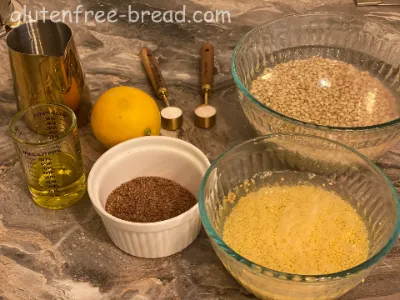
Soak Buckwheat (200 gr) and Millet (150 gr) minimum for 4 hours. Soak Buckwheat (200 gr) and Millet (150 gr) minimum for 4 hours.
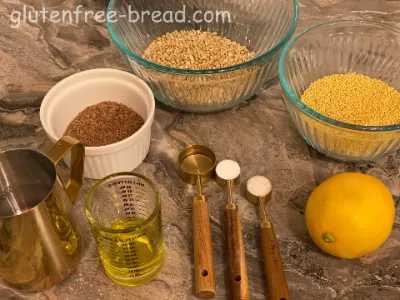
Preheat the oven to 350°F (180°C) and line the bread pan with parchment paper. Preheat the oven to 350°F (180°C) and line the bread pan with parchment paper.
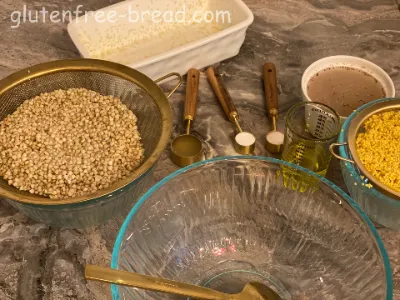
After soaking, rinse and drain the millet and buckwheat using a fine-mesh sieve or colander. After soaking, rinse and drain the millet and buckwheat using a fine-mesh sieve or colander.

Combine Ground Flaxseed (30 gr) and Water (200 ml), stir it and allow to sit for about 5 minutes. Combine Ground Flaxseed (30 gr) and Water (200 ml), stir it and allow to sit for about 5 minutes.
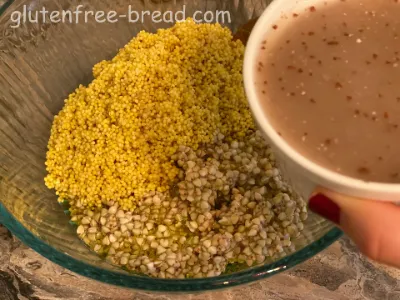
In a large bowl combine soaked Buckwheat, soaked Millet, Oil (25 ml) and Flaxseed Mixture. In a large bowl combine soaked Buckwheat, soaked Millet, Oil (25 ml) and Flaxseed Mixture.
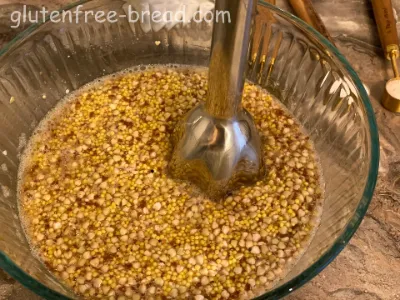
Blend but Do Not Blend everything completely smoothly or else the texture of the bread will become crumbly. Blend but Do Not Blend everything completely smoothly or else the texture of the bread will become crumbly.
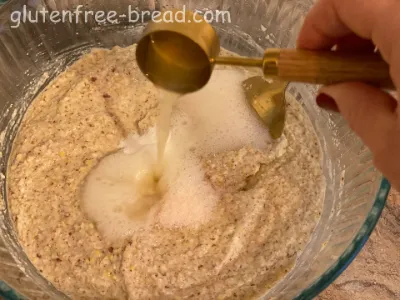
Add Salt (1 tsp), Baking Soda (6 gr), Lemon Juice (15 ml) and Seeds of your choice. Mix it with a spoon until well combined. Add Salt (1 tsp), Baking Soda (6 gr), Lemon Juice (15 ml) and Seeds of your choice. Mix it with a spoon until well combined.
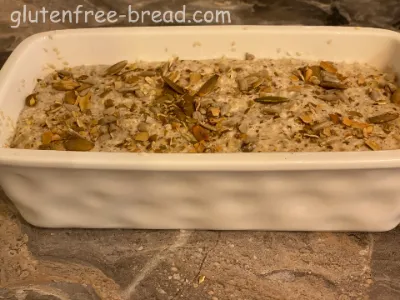
Transfer the batter to the prepared pan. Smooth the top out with a spatula and sprinkle with seeds. Transfer the batter to the prepared pan. Smooth the top out with a spatula and sprinkle with seeds.

Bake for 90 minutes (depending on your pan size) at 350°F (180°C) until a toothpick inserted into the middle comes out clean. Bake for 90 minutes (depending on your pan size) at 350°F (180°C) until a toothpick inserted into the middle comes out clean.
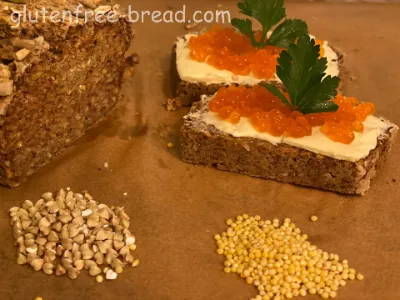
Remove the bread from the oven and let it cool in the pan for 10 minutes, then transfer the bread to a wire rack to cool completely before slicing. Remove the bread from the oven and let it cool in the pan for 10 minutes, then transfer the bread to a wire rack to cool completely before slicing.
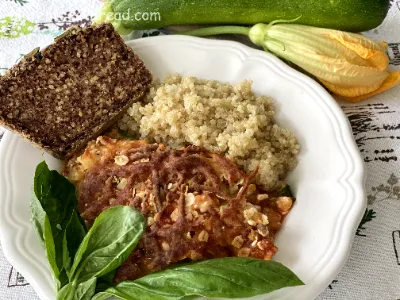
Slice the bread and serve it alongside a hearty lasagna. Its nutty flavor and wholesome texture can complement the richness of the Sheet Pan Zucchini Lasagne. Slice the bread and serve it alongside a hearty lasagna. Its nutty flavor and wholesome texture can complement the richness of the Sheet Pan Zucchini Lasagne.
Comments:
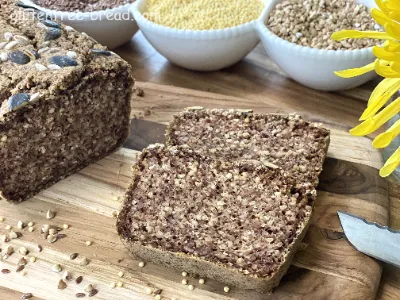
Buckwheat Millet Flaxseed Bread
It's important not to blend buckwheat groats and millet completely smooth for a few key reasons:
Crumbly Texture: When grains are blended too finely, they can lose their structure and integrity within the bread dough. This can lead to a loaf that crumbles easily when sliced or handled, rather than holding together in cohesive slices.
Sand-like Texture: Over-blending can result in a texture that resembles sand or grit in the bread. This occurs because the grains, when pulverized too finely, create a powdery consistency that doesn't integrate well with the other ingredients, affecting the overall mouthfeel of the bread.
Texture and Mouthfeel: Leaving some texture in the grains adds to the overall texture of the bread. It provides a pleasant chewiness and a bit of crunch from the grains, which enhances the eating experience. Completely blending them smooth would result in a more uniform and possibly denser texture, which may not be as desirable in bread.
Affect on Moisture Balance: Fine blending can also affect the moisture balance in the bread dough. The finely ground grains may absorb moisture differently than whole or coarsely ground grains, potentially leading to a drier or more compact loaf.
Appearance and Presentation: Bread with visible grains can be visually appealing. It shows the wholesome ingredients used and adds to the rustic charm of homemade bread. A completely smooth texture might lack visual interest and not convey the same rustic appeal.
Flavor Development: Keeping the grains partially intact allows them to release their flavors more gradually during baking, contributing to a more complex and satisfying flavor profile. Completely blending them smooth could potentially alter or diminish these flavors.
How to Avoid These Issues:
Pulse Instead of Continuous Blend: Use a food processor or blender to pulse the grains briefly, rather than running it continuously. This allows you to break down the grains slightly while still maintaining some texture and structure.
Mix in Gradually: After pulsing, mix the grains with the other dry ingredients and wet ingredients by hand. This helps distribute them evenly throughout the batter without further pulverizing them.
Fold in Add-ins Carefully: If you're adding additional ingredients like seeds or nuts, fold them in gently after the batter is mixed to avoid further breaking down the grains.
Benefits of Maintaining Texture:
Enhanced Flavor and Texture: Keeping some texture in the grains preserves their natural flavors and enhances the overall texture of the bread, providing a more satisfying eating experience.
Visual Appeal: Bread with visible grains has a rustic and homemade appearance, which can be visually appealing and inviting.
Structural Integrity: Intact grains contribute to the structure and stability of the loaf, helping it rise properly during baking and maintain its shape after cooling.
By being mindful of how you process and incorporate buckwheat groats and millet in your bread recipe, you can achieve a balanced texture that enhances both the flavor and structural integrity of your final baked product.
Buckwheat Millet Flaxseed Bread additional information:
The nutritional properties of Buckwheat Millet Flaxseed Bread
Buckwheat Groats:
- Protein: Buckwheat is relatively high in protein compared to many other grains, providing essential amino acids.
- Fiber: It contains both soluble and insoluble fiber, which can aid digestion and promote a feeling of fullness.
- Minerals: Buckwheat is a good source of minerals such as manganese, magnesium, and phosphorus.
Millet:
- Protein: Millet is rich in protein, comparable to wheat and rice.
- Nutrients: It provides vitamins and minerals, including B vitamins (niacin, thiamine, and riboflavin), magnesium, and phosphorus.
- Digestibility: Millet is easily digestible and is often recommended for those with sensitive digestive systems.
Flax Seeds:
- Omega-3 Fatty Acids: Flax seeds are one of the richest plant sources of alpha-linolenic acid (ALA), a type of omega-3 fatty acid important for heart health.
- Fiber: They are high in dietary fiber, which supports digestive health and helps regulate cholesterol levels.
- Antioxidants: Flax seeds contain lignans, which have antioxidant properties.
Overall Benefits:
- Gluten-Free: This bread is typically gluten-free if made with gluten-free buckwheat and millet flours, making it suitable for individuals with gluten intolerance or celiac disease.
- High in Protein: The combination of buckwheat, millet, and flax seeds provides a good amount of plant-based protein, which is essential for muscle repair and overall body function.
- Healthy Fats: Flax seeds contribute healthy fats, including omega-3s, which are beneficial for heart health and inflammation reduction.
Considerations:
- Caloric Content: Bread made from these ingredients may be higher in calories compared to traditional wheat bread due to their higher fat and protein content.
- Fiber Content: The bread is likely to be higher in fiber, which supports digestive health and helps maintain stable blood sugar levels.
- Vitamins and Minerals: Depending on the specific ingredients used and their processing, the bread can provide a range of vitamins and minerals essential for overall health.
Enjoying the Bread:
Incorporating Buckwheat Millet Flaxseed Bread into your diet can provide a nutrient-dense alternative to traditional bread options. Its combination of proteins, healthy fats, fiber, and essential nutrients makes it a wholesome choice for those looking to enhance their diet with nutritious ingredients. Adjustments in the recipe can further tailor the nutritional profile to meet specific dietary needs or preferences.
Buckwheat Millet Flaxseed Bread pairs well with a variety of foods and flavors, thanks to its nutty taste and hearty texture. Here are some delicious pairings to consider:
Soups and Stews: Serve slices of the bread alongside hearty soups like lentil soup, vegetable stew, or creamy potato soup. The bread's texture and flavor complement the warmth and richness of these dishes.
Cheeses and Spreads: Enjoy the bread with a selection of cheeses such as goat cheese, sharp cheddar, or brie. Pair it with spreads like hummus, pesto, or roasted red pepper spread for added flavor.
Salads: Use the bread to make croutons for salads or serve it alongside fresh salads like mixed greens with vinaigrette, quinoa salad, or roasted vegetable salad. The bread adds crunch and substance to lighter dishes.
Eggs and Breakfast: Toast slices of the bread and serve with scrambled eggs, avocado slices, or smoked salmon for a nutritious breakfast or brunch option. It also pairs well with jams or nut butter for a sweet and savory combination.
Dips and Salsas: Serve the bread with dips such as tzatziki, guacamole, or salsa for a tasty appetizer or snack. The bread's texture holds up well to dipping and adds a satisfying crunch.
Grilled Sandwiches: Use the bread to make grilled sandwiches with fillings like grilled vegetables, chicken, turkey, or melted cheese. The nutty flavor of the bread complements a variety of savory fillings.
Cheese Platters: Include slices of the bread on a cheese platter with fruits like grapes or apples, nuts, and olives. It adds a hearty element to the assortment of flavors.
Baked Goods: Use the bread to make open-faced sandwiches topped with avocado, tomatoes, and a sprinkle of herbs for a light lunch or snack.
Experiment with these pairings to discover your favorite ways to enjoy Buckwheat Millet Flaxseeds Bread. Its versatility makes it suitable for a range of meals and occasions, whether you're looking for a savory accompaniment or a wholesome base for sweet or savory toppings.
